Black and White on Red Hopi Cylindrical Jar by Annie Healing Nampeyo - 25927
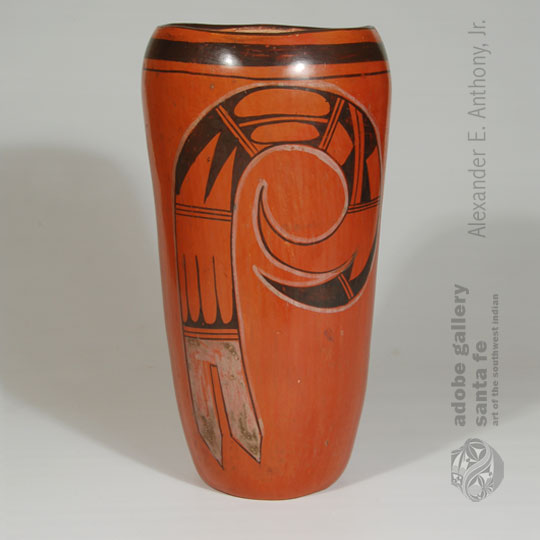 It is always difficult to make attributions to pottery because there is always the chance that there was another potter who produced similar work but is not currently known to us. This pictorial tall cylindrical jar has been attributed to Annie Healing Nampeyo based on the shape of the beautiful curved outline of the bird design, which is like others by her, and the white outlining of design elements for which she was very well known.
It is always difficult to make attributions to pottery because there is always the chance that there was another potter who produced similar work but is not currently known to us. This pictorial tall cylindrical jar has been attributed to Annie Healing Nampeyo based on the shape of the beautiful curved outline of the bird design, which is like others by her, and the white outlining of design elements for which she was very well known.
Annie, and her mother, Nampeyo, both made red pottery, but Annie seems to have favored it more than did Nampeyo. Annie also seems to have used white outlining and white pigment in the design more than did Nampeyo. The elegant layout of the stylized bird design could only have been done by one of them and we have safely chosen Annie as the artist.
Navajo Sterling Silver Scallop Edge Bracelet with Turquoise - C3864.11
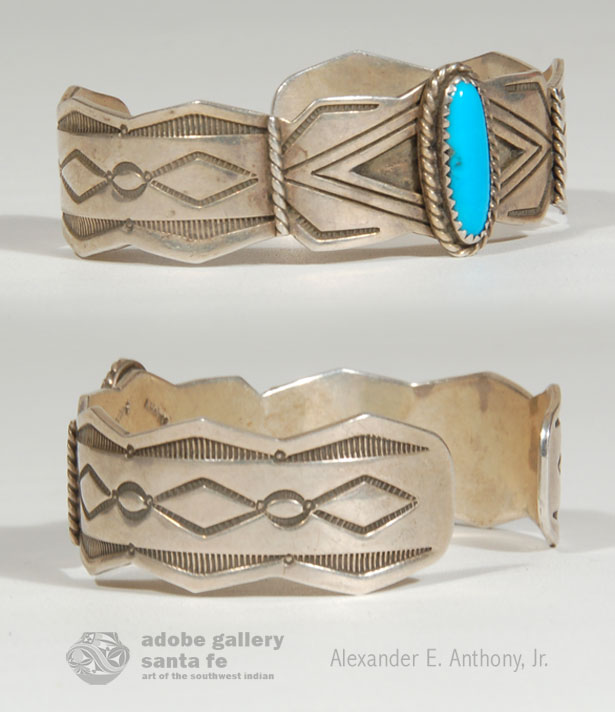 The Sterling Silver Scallop Edge Bracelet with Turquoise is stamped AHolyen and Sterling. It is a Navajo-style bracelet but there is no artisan by that name in our reference books. It was beautifully fabricated with scallop edges and traditional stamped designs. The single blue turquoise cab is a beautiful color devoid of matrix.
The Sterling Silver Scallop Edge Bracelet with Turquoise is stamped AHolyen and Sterling. It is a Navajo-style bracelet but there is no artisan by that name in our reference books. It was beautifully fabricated with scallop edges and traditional stamped designs. The single blue turquoise cab is a beautiful color devoid of matrix.
Mineral Earth Painting of Swimming Mimbres Turtles by Pablita Velarde - C3876L
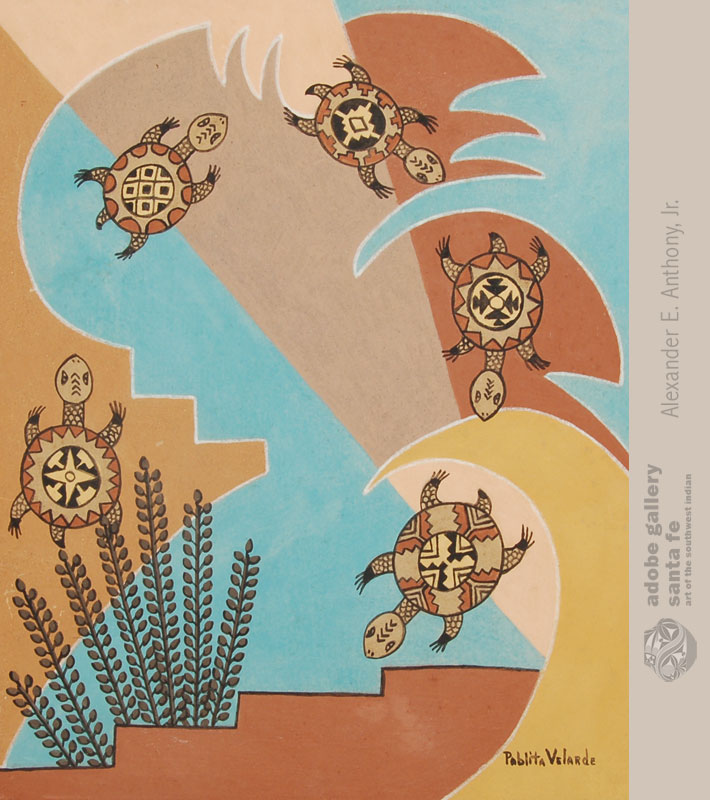 Pablita Velarde (1918-2006) Tse Tsan - Golden Dawn of Santa Clara Pueblo is best known for her earth paintings, where she used mineral and rock elements, which she would grind on a metate and mano until the result was a powdery substance from which she made her paints. This is an earth painting illustrating five Mimbres turtles swimming through some plant materials. Pablita made a varied color and varied shape background to provide visual contrast to the painting.
Pablita Velarde (1918-2006) Tse Tsan - Golden Dawn of Santa Clara Pueblo is best known for her earth paintings, where she used mineral and rock elements, which she would grind on a metate and mano until the result was a powdery substance from which she made her paints. This is an earth painting illustrating five Mimbres turtles swimming through some plant materials. Pablita made a varied color and varied shape background to provide visual contrast to the painting.
Would you like to know more? (Click here.)
Mixed Media Painting - Titled A Winter Silence by Tony Abeyta - C3876B
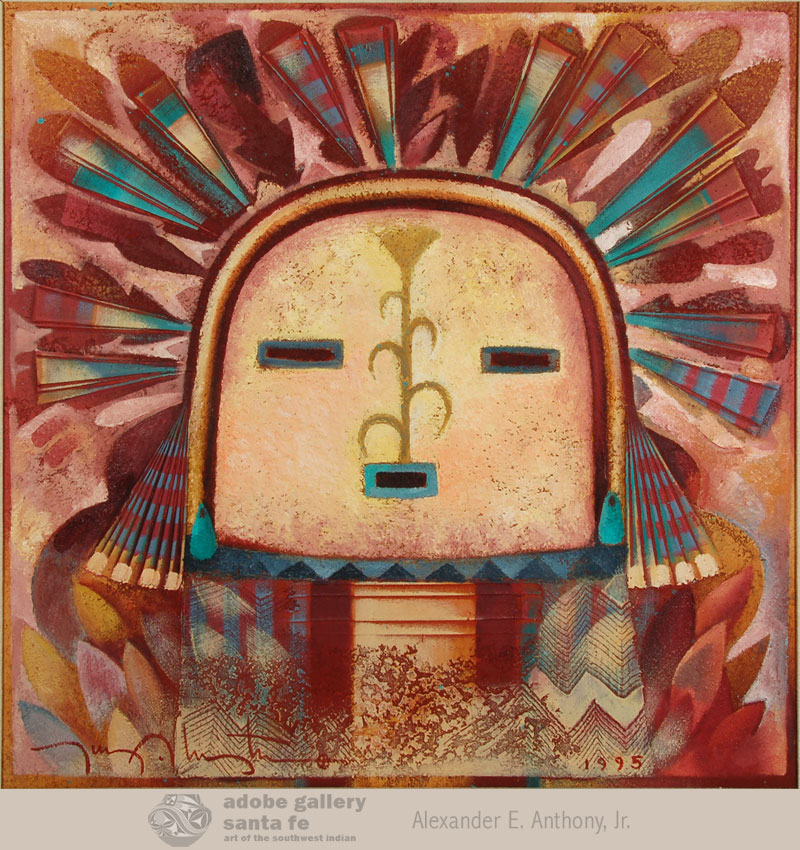 The image on this canvas is that of a Navajo *Yei. The Yei are the Supernatural Beings of the Diné. They may be presented in male or female form. This mask is that of a male. When this painting was executed in the mid-1990s, Tony Abeyta was strongly into and influenced by Navajo religion-painting Yei figures, sandpainting imagery, and other Diné religious subjects.
The image on this canvas is that of a Navajo *Yei. The Yei are the Supernatural Beings of the Diné. They may be presented in male or female form. This mask is that of a male. When this painting was executed in the mid-1990s, Tony Abeyta was strongly into and influenced by Navajo religion-painting Yei figures, sandpainting imagery, and other Diné religious subjects.
This painting is titled A Winter Silence and was completed in 1995. It is a mixed media painting of oil paints and sand on canvas. It is signed in lower left and dated in lower right. The artist added the title, medium, date and his signature on the back of the canvas. At the time of this painting, Tony Abeyta lived in Taos, New Mexico, and added that information on the back of the canvas, too.
Would you like to know more? (Click here.)
Navajo Silver Twisted Wire and Kingman Turquoise Bracelet - C3864.07
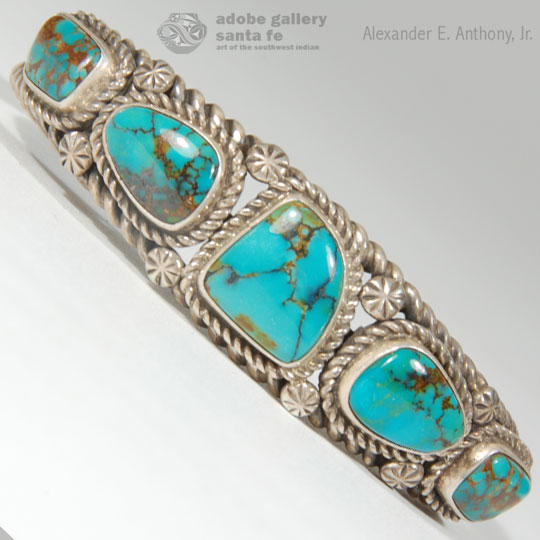 The foundation of the bracelet is a silver bar with silver twisted wires on the outer edges. The three silver foundation pieces are spread at the top and soldered together at the ends. There are five beautiful blue Kingman turquoise cabs mounted on top, each in a silver bezel surrounded by fine silver twisted wire.
The foundation of the bracelet is a silver bar with silver twisted wires on the outer edges. The three silver foundation pieces are spread at the top and soldered together at the ends. There are five beautiful blue Kingman turquoise cabs mounted on top, each in a silver bezel surrounded by fine silver twisted wire.
The twisted wires add a touch of Victorian antiquity to the appearance; however, the Silver Twisted Wire and Kingman Turquoise Bracelet is relatively new. It is stamped with the initials JL but we do not know the artist associated with those initials.
Would you like to know more. (Click here)
Ohkay Owingeh (San Juan) Pueblo Clown Figure Carving - C3535.36
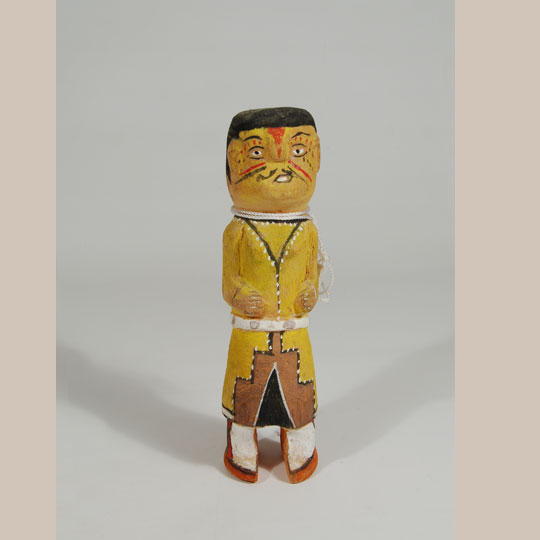 A Tewa Indian from a neighboring pueblo to Ohkay Owingeh told us that the old San Juan Pueblo celebrates so few Katsina dances that very little is known anymore about their katsinas and clowns. He thought this might be a representation of a clan from the pueblo, particularly of the Summer People's pumpkin group. In the Northern New Mexico Pueblos, the society is made up of two moieties-the Winter People and the Summer People. Each moiety is headed by a chief. The Summer Chief is the authority from February to September and the Winter Chief is in charge the remainder of the year.
A Tewa Indian from a neighboring pueblo to Ohkay Owingeh told us that the old San Juan Pueblo celebrates so few Katsina dances that very little is known anymore about their katsinas and clowns. He thought this might be a representation of a clan from the pueblo, particularly of the Summer People's pumpkin group. In the Northern New Mexico Pueblos, the society is made up of two moieties-the Winter People and the Summer People. Each moiety is headed by a chief. The Summer Chief is the authority from February to September and the Winter Chief is in charge the remainder of the year.
Hopi Overlay Belt Buckle Signed Lomawywesa by Michael Kabotie - C3852L
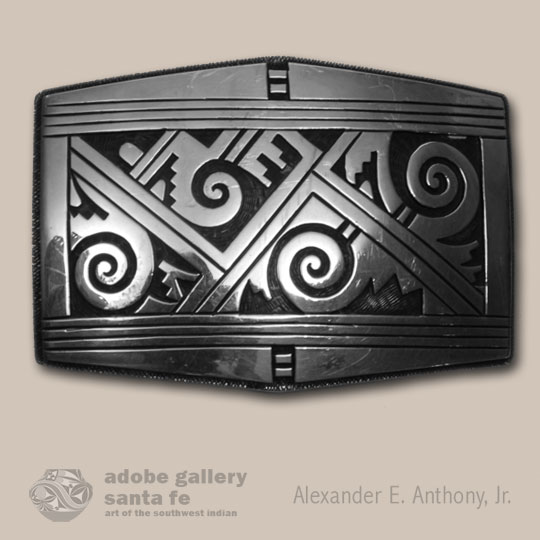 This buckle is stamped on the back with the name Lomawywesa, the Hopi name of Michael Kabotie. It is a buckle of excellent craftsmanship. The design is quite complicated and interesting, almost a representation of stylized birds from prehistoric Hopi pottery.
This buckle is stamped on the back with the name Lomawywesa, the Hopi name of Michael Kabotie. It is a buckle of excellent craftsmanship. The design is quite complicated and interesting, almost a representation of stylized birds from prehistoric Hopi pottery.
Hopi Pueblo Overlay Sterling Silver Belt Buckle by Philbert Poseyesva - C3852M
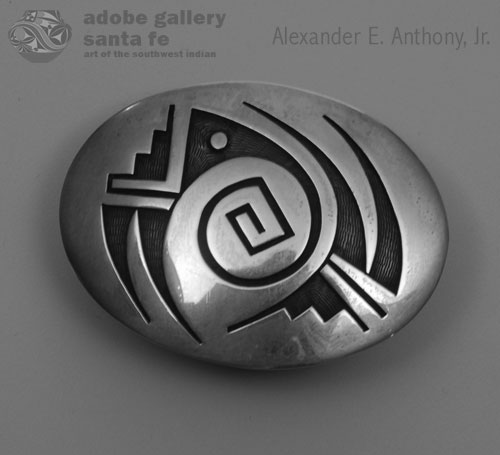 Phil Poseyesva's hallmark is a bear paw with his last name superimposed. He is one of the recognized Hopi jewelers whose works are sought by collectors. He has been an active jeweler since circa 1973 and is still producing. He learned the processes of Hopi overlay through instructions at the Hopi Silvercraft Cooperative Guild on Second Mesa. He has lived in the villages of Mishongnovi, Oraibi and Kykotsmovi.
Phil Poseyesva's hallmark is a bear paw with his last name superimposed. He is one of the recognized Hopi jewelers whose works are sought by collectors. He has been an active jeweler since circa 1973 and is still producing. He learned the processes of Hopi overlay through instructions at the Hopi Silvercraft Cooperative Guild on Second Mesa. He has lived in the villages of Mishongnovi, Oraibi and Kykotsmovi.
Poseyesva has won awards for many years at Santa Fe Indian Market. His work has been exhibited at Eiteljorg Museum in Indianapolis, Southwest Museum in Los Angeles, and Gilcrease Museum in Tulsa.
Would you like to know more? (Click here)
Navajo Silver and Turquoise Wide Band Ring - C3864.38
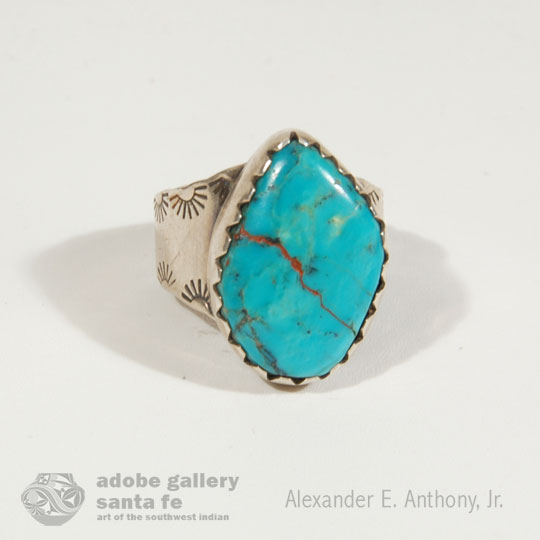 A beautiful wide silver band with "rising sun" stampings on its edges is the foundation for a beautiful blue turquoise cab which is anchored in a wide silver bezel with serrated edges. The Silver and Turquoise Wide Band Ring imparts a feeling of massiveness and strength. The dark line crossing the turquoise is the natural matrix of the stone. The ring is not signed with the name of the Navajo Nation artist.
A beautiful wide silver band with "rising sun" stampings on its edges is the foundation for a beautiful blue turquoise cab which is anchored in a wide silver bezel with serrated edges. The Silver and Turquoise Wide Band Ring imparts a feeling of massiveness and strength. The dark line crossing the turquoise is the natural matrix of the stone. The ring is not signed with the name of the Navajo Nation artist.
Zuni Pueblo Saiyatasha Katsina Doll by Duane Dishta - C3535.62
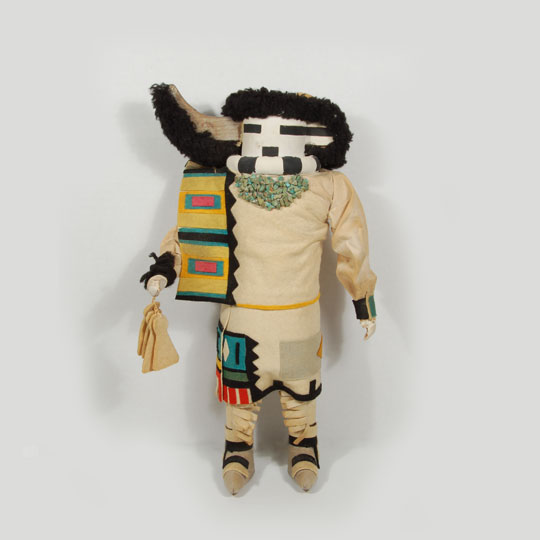 During his period of impersonating Saiyatasha, the Zuni man holds a position of great responsibility, power and prestige and assumes the rank and importance of one of the major priests of Zuni. It is he who must decide the ceremonial calendar for the year and must watch over the phases of the moon for the full year. He sets the date of the Shalako Ceremonies and insures that they do not conflict with other ceremonial events. He must learn all of the lengthy prayers, chants, and speeches while attending nightly meetings that last from the Zuni New Year until Shalako. In addition, he is required to make journeys to springs from four to eight miles distant to offer prayers each month during the year. He must also pray to the sun each day and work to prevent the frosts of spring and fall since he represents a katsina who makes the days warm.
During his period of impersonating Saiyatasha, the Zuni man holds a position of great responsibility, power and prestige and assumes the rank and importance of one of the major priests of Zuni. It is he who must decide the ceremonial calendar for the year and must watch over the phases of the moon for the full year. He sets the date of the Shalako Ceremonies and insures that they do not conflict with other ceremonial events. He must learn all of the lengthy prayers, chants, and speeches while attending nightly meetings that last from the Zuni New Year until Shalako. In addition, he is required to make journeys to springs from four to eight miles distant to offer prayers each month during the year. He must also pray to the sun each day and work to prevent the frosts of spring and fall since he represents a katsina who makes the days warm.
The above information was excerpted from the out-of-print book Kachinas of the Zuni by Barton Wright with original paintings provided by Duane Dishta. This Zuni Long Horn Priest of the North - Saiyatasha Katsina Doll is not signed, but was shown to Dishta who identified it as one he made in the 1960s.
Zuni Pueblo Kianakwe Thlian Kachina Doll by Duane Dishta - C3535.61
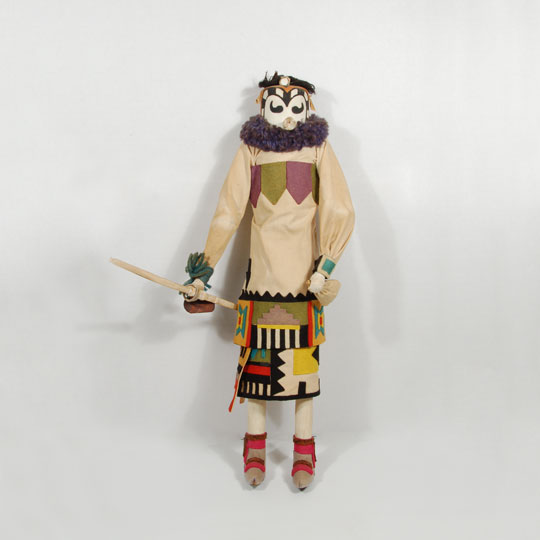 One of the oldest of Zuni legends describes how the Zuni overtook and conquered their enemy, the Kainakwe, a group of Indians far to the South. In observance of this event, the Zuni perform a one-day dance called the Kianakwe Ceremony that follows an eight-day retreat. It is unique in that it is performed only by the Corn Clan and is a dance involving the distribution of large amounts of food and goods.
One of the oldest of Zuni legends describes how the Zuni overtook and conquered their enemy, the Kainakwe, a group of Indians far to the South. In observance of this event, the Zuni perform a one-day dance called the Kianakwe Ceremony that follows an eight-day retreat. It is unique in that it is performed only by the Corn Clan and is a dance involving the distribution of large amounts of food and goods.
The above information was excerpted from the out-of-print book Kachinas of the Zuni by Barton Wright with original paintings provided by Duane Dishta. A much more detailed explanation of this Zuni Katsina may be found in the book. This Katsina doll is not signed, but was shown to Dishta who identified it as one he made in the 1960s.
Hopi Pueblo Sterling Silver Butterfly Belt Buckle by Steven Sockyma - C3852P
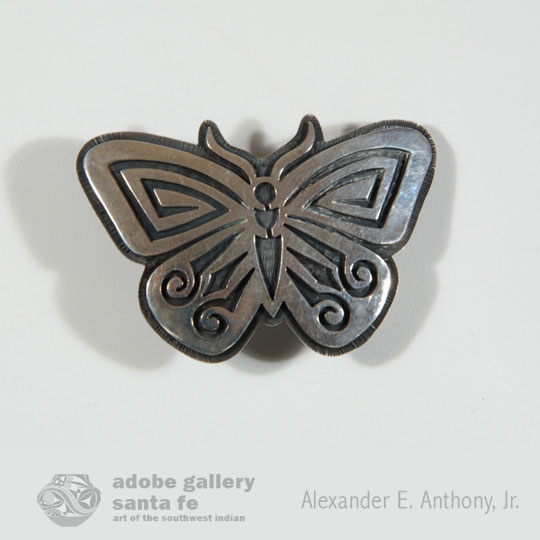 The Hopi Arts & Crafts Co-op Guild was formed in 1947, after World War II, when returning Hopi Pueblo servicemen were trained at a silversmithing school founded under the G.I. bill. The late Paul Saufkie, Sr. was the technical instructor and the late Fred Kabotie, noted Hopi artist and designer, taught design. Although many techniques of silver work were used, the overlay style gradually emerged as the dominate style. This simple, unique, elegant jewelry is now considered essentially the Hopi style of jewelry.
The Hopi Arts & Crafts Co-op Guild was formed in 1947, after World War II, when returning Hopi Pueblo servicemen were trained at a silversmithing school founded under the G.I. bill. The late Paul Saufkie, Sr. was the technical instructor and the late Fred Kabotie, noted Hopi artist and designer, taught design. Although many techniques of silver work were used, the overlay style gradually emerged as the dominate style. This simple, unique, elegant jewelry is now considered essentially the Hopi style of jewelry.
Steven Sockyma is a Hopi member of the Corn Clan. He has been actively making jewelry since 1969. He was born in the Third Mesa village Hotevilla and now lives in Glorieta, New Mexico.
Hopi Pueblo Sterling Silver Kokopelli Belt Buckle by Steven Sockyma - C3852o
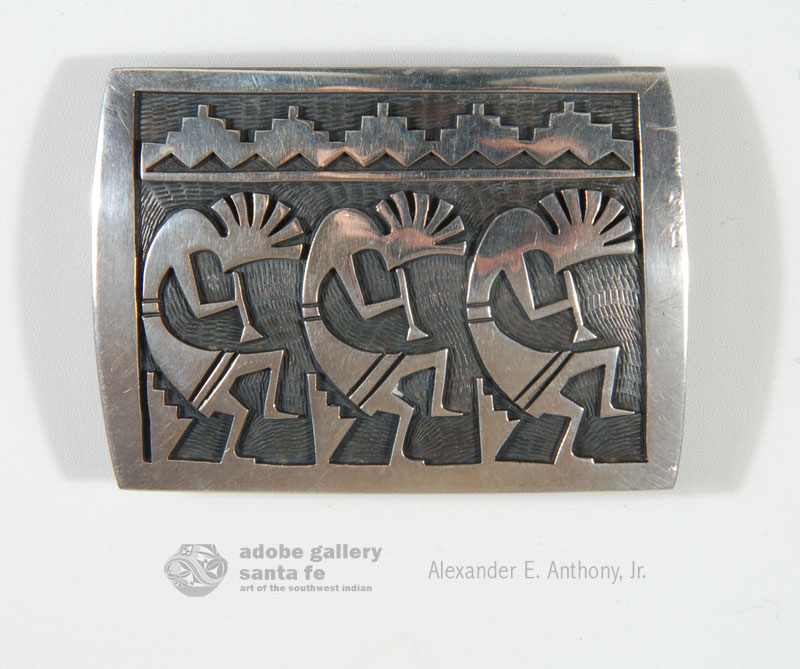 Steven Sockyma is a Hopi member of the Corn Clan at Hopi Pueblo. He has been actively making jewelry since 1969. He was born in the Third Mesa village Hotevilla and now lives in Glorieta, New Mexico. He has been a 1st place winner at Santa Fe Indian Market. Overlay technique consists of an upper layer in which the design has been intricately cut out with a saw.
Steven Sockyma is a Hopi member of the Corn Clan at Hopi Pueblo. He has been actively making jewelry since 1969. He was born in the Third Mesa village Hotevilla and now lives in Glorieta, New Mexico. He has been a 1st place winner at Santa Fe Indian Market. Overlay technique consists of an upper layer in which the design has been intricately cut out with a saw.
Navajo Sterling Silver Earrings in Style of Conchas - C3864.44
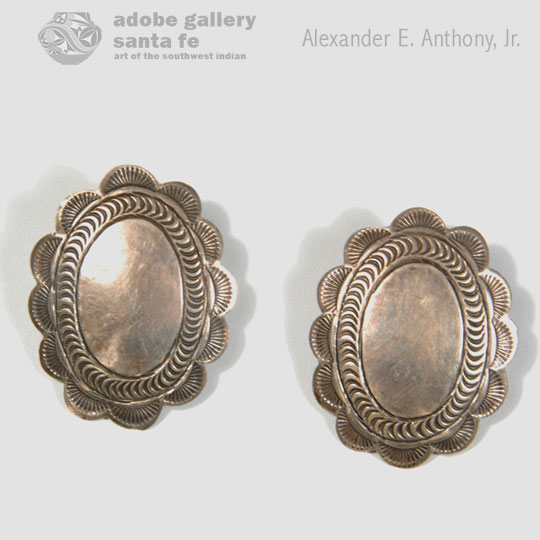 This is the perfect pair of earrings to wear with an all-silver concha belt. They are designed in the shape of conchas as seen on belts. They are equipped with posts for pierced ears.
This is the perfect pair of earrings to wear with an all-silver concha belt. They are designed in the shape of conchas as seen on belts. They are equipped with posts for pierced ears.
Navajo Sterling Silver Stamped Cruciform Earrings - C3864.45
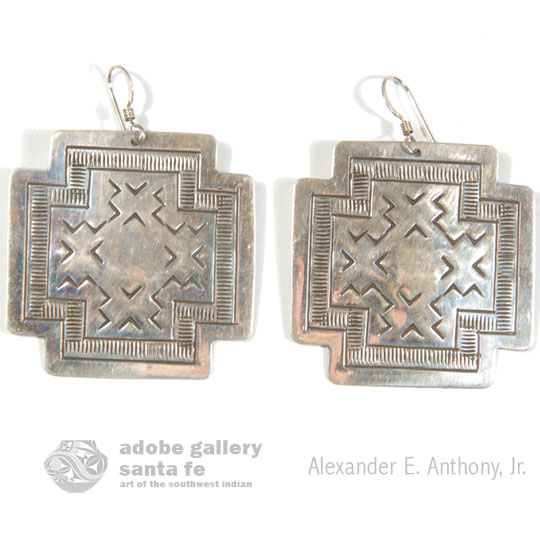 This pair of sterling silver earrings is stamped with designs that reflect those seen on Navajo rugs. Perhaps the females in his family are rug weavers.
This pair of sterling silver earrings is stamped with designs that reflect those seen on Navajo rugs. Perhaps the females in his family are rug weavers.
Hopi Pueblo Four Color Polychrome Jar by Mark Tahbo - 25931
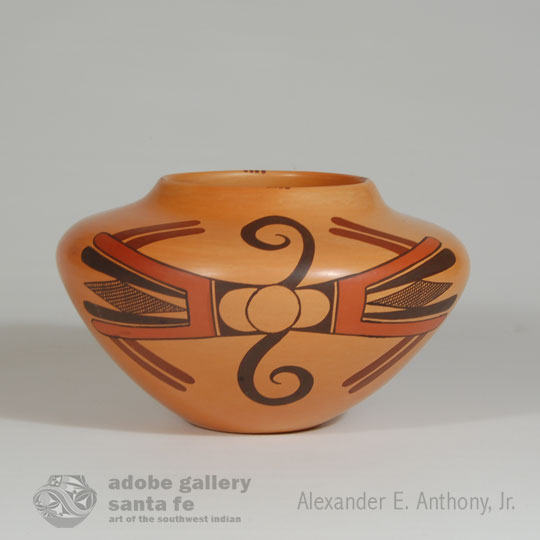 Mark Tahbo often places his designs within framing lines, but chose not to with this jar because the original image worked so well as a free-floating design inside Nampeyo's bowl. The most notable difference between Nampeyo's and Tahbo's versions is that Nampeyo's design featured feather designs, which Tahbo chose to replace with his own elaborate diamond hatchwork.
Mark Tahbo often places his designs within framing lines, but chose not to with this jar because the original image worked so well as a free-floating design inside Nampeyo's bowl. The most notable difference between Nampeyo's and Tahbo's versions is that Nampeyo's design featured feather designs, which Tahbo chose to replace with his own elaborate diamond hatchwork.
Navajo Cast Silver and Turquoise Belt Buckle - C3864.31
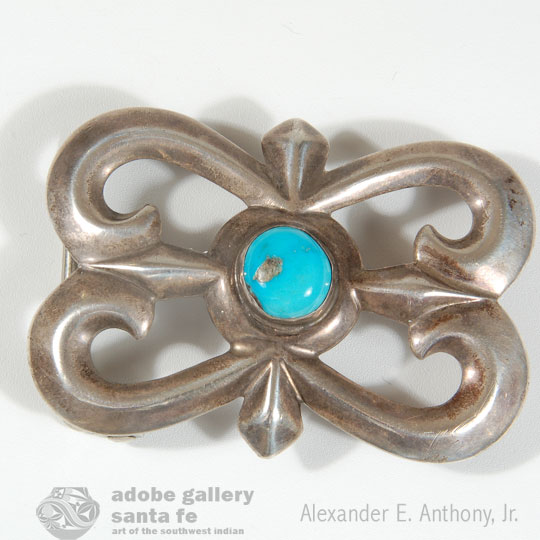 Tufa casting, often erroneously referred to as sand casting, is one of the earliest techniques used by the Navajo smiths. Today, it is still accomplished in the same manner as it was 150 years ago. This buckle was cast in silver, and then painstakingly polished and refined to a smooth finish.
Tufa casting, often erroneously referred to as sand casting, is one of the earliest techniques used by the Navajo smiths. Today, it is still accomplished in the same manner as it was 150 years ago. This buckle was cast in silver, and then painstakingly polished and refined to a smooth finish.
Before a cast buckle such as this one can be made by an artisan, he or she must first fashion a mold from a whitish sandstone rock, hard enough to withstand the hot metal without splitting and yet soft enough to be grooved into the wanted design. Today, these can be purchased at local jewelry supply stores, but in earlier days, the artisan searched the Reservation for suitable rock and carved the desired design himself. When one of these molds broke, perhaps from not having been warm enough to receive the molten silver, it was a minor tragedy. Today, it is a slight inconvenience. Now, a new one can be purchased on the next trip into town.
Oil on Canvas Painting of Mountain Landscape by Tony Abeyta - 25938
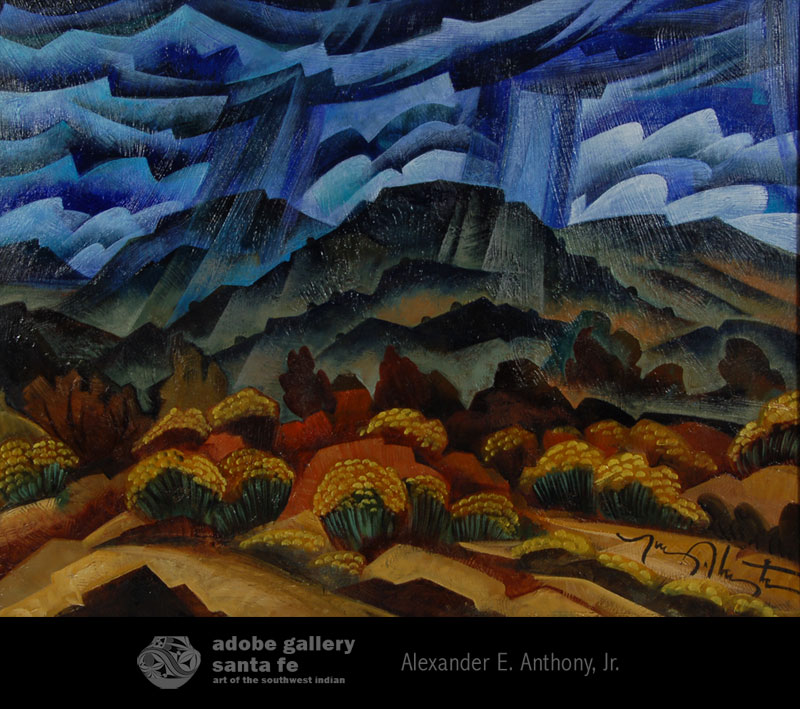 Santa Feans know that the annual rainfalls will start in early July and continue through August. That is referred to as the monsoon season even though the rainstorms last only about 30 minutes in late afternoon, followed by the return of the sun. The downpour can be significant in that half hour. Rain falls in isolated regions rather than all over the area.
Santa Feans know that the annual rainfalls will start in early July and continue through August. That is referred to as the monsoon season even though the rainstorms last only about 30 minutes in late afternoon, followed by the return of the sun. The downpour can be significant in that half hour. Rain falls in isolated regions rather than all over the area.
In this Oil on Canvas Painting of Mountain Landscape, Tony Abeyta has placed the rain storm in the mountains and foothills. The clouds are various shades of blue and cast a darkness over the area. The mountains are green from previous summer storms. In the foreground, the chamissa is blooming in a beautiful yellow hue, the ground is yellow and brown, and the small bushes in the background are dark red.
Navajo Sterling Silver Tufa Cast Bracelet with a Turquoise Cab - C3864.08
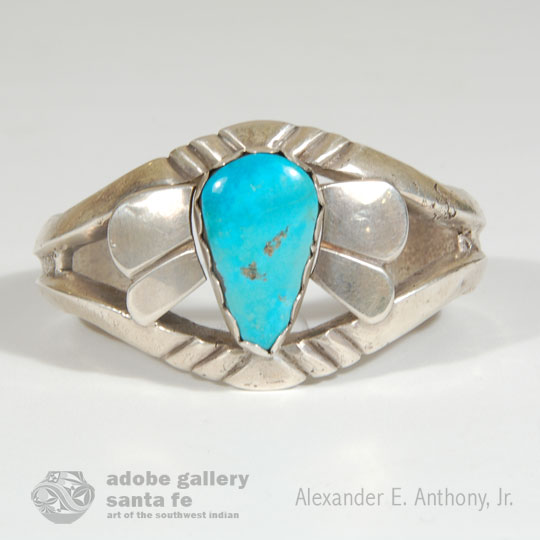 The silver band was formed in the tufa-casting manner by which molten silver was poured into a tufa mold that had been carved in the desired shape and pattern. Once removed from the mold, the band was then heated and curved to its present shape. The four silver rays around the stone appear to be hand hammered and soldered onto the band. A large tear drop turquoise cab was then set in a scalloped silver bezel and attached to the bracelet. There is no artist stamp or signature on this Sterling Silver Tufa Cast Bracelet with a Turquoise Cab.
The silver band was formed in the tufa-casting manner by which molten silver was poured into a tufa mold that had been carved in the desired shape and pattern. Once removed from the mold, the band was then heated and curved to its present shape. The four silver rays around the stone appear to be hand hammered and soldered onto the band. A large tear drop turquoise cab was then set in a scalloped silver bezel and attached to the bracelet. There is no artist stamp or signature on this Sterling Silver Tufa Cast Bracelet with a Turquoise Cab.
Hopi Tewa Large Polychrome Seed Jar by Mark Tahbo - 25929
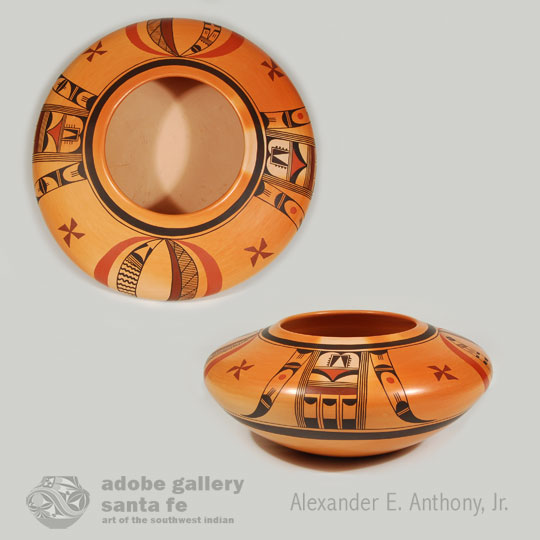 It is no surprise that Mark Tahbo's work appeals to collectors of contemporary pottery. He is an excellent potter whose creations, while varied in form and design, always display a mastery of his craft. What is interesting is that his pottery has begun to attract the attention of collectors who focus primarily on historic pottery. This is most likely because he so gracefully blends his own ideas with the classic Hopi Pueblo designs that inspired him to begin potting in the first place.
It is no surprise that Mark Tahbo's work appeals to collectors of contemporary pottery. He is an excellent potter whose creations, while varied in form and design, always display a mastery of his craft. What is interesting is that his pottery has begun to attract the attention of collectors who focus primarily on historic pottery. This is most likely because he so gracefully blends his own ideas with the classic Hopi Pueblo designs that inspired him to begin potting in the first place.
This jar is an excellent example of Mark Tahbo doing just that-seamlessly blending his own designs with those made famous by Hopi matriarch Nampeyo of Hano. He explained to us that the ovular designs, which include "curled feathers," were inspired by Nampeyo's corn designs. Here, they have been turned upright. Instead of using the crisscrossing migration pattern lines, he used a simpler set of horizontal lines which are crossed diagonally-his own interpretation of a master potter's designs.
Here is a video of Mark talking about this pot.

